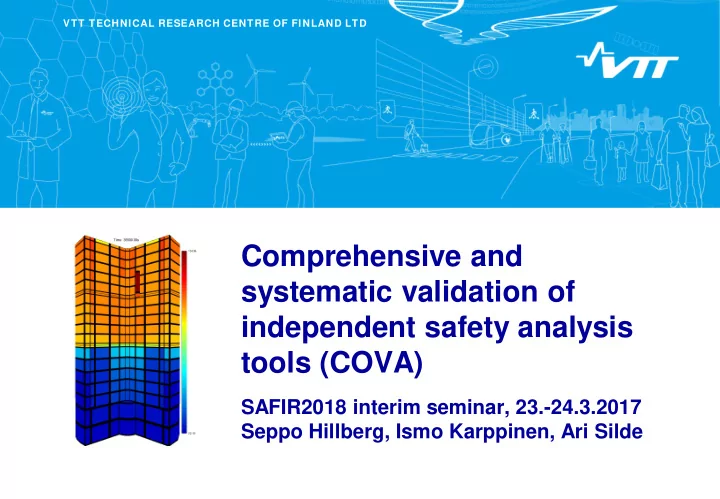

VTT TECHNICAL RESEARCH CENTRE OF FINLAND LTD Comprehensive and systematic validation of independent safety analysis tools (COVA) SAFIR2018 interim seminar, 23.-24.3.2017 Seppo Hillberg, Ismo Karppinen, Ari Silde
Critical assessment of thermal-hydraulic and containment models' validation � One the overall objectives of the COVA project is to improve the state of Apros' validation. � The project started in 2015 with an assessment of Apros's thermal-hydraulic and containment models' validation by compiling databases of the calculated validation cases and then by comparing them to the OECD/NEA's separate effects and containment validation test matrices. This work formed a foundation on which much of the work done in COVA during its four-year period is based. 02/05/2017 2 2
What are OECD/NEA’s validation matrices? An internationally agreed separate effect test (SET) Validation Matrix for thermal- hydraulic system codes has been established by a sub-group on Task Group Thermal Hydraulic System Behaviour, as requested by the OECD/NEA Committee on Safety of Nuclear Installations (CSNI) Principal Working Group No. 2 on Coolant System Behaviour. The construction of such a matrix is an attempt to collect together in a systematic way the best sets of openly available test data for code validation, assessment and improvement, including quantitative assessment of uncertainties in the modelling of individual phenomena by the codes. The Committee on the Safety of Nuclear Installations (CSNI) formed the CCVM (Containment Code Validation Matrix) task group in 2002. The objective of this group was to define a basic set of available experiments for code validation, covering the range of containment (ex-vessel) phenomena expected in the course of light and heavy water reactor design basis accidents and beyond design basis accidents/severe accidents. It was to consider phenomena relevant to pressurised heavy water reactor (PHWR), pressurized water reactor (PWR) and boiling water reactor (BWR) designs of Western origin as well as of Eastern European VVER types. 02/05/2017 3 3
Assessment against the test matrices Both validation assessment works began by gathering lists of all validation cases calculated with Apros and Apros containment throughout its development history, including information on what code version was used for each analysis and what kind of results was obtained. An assessment was then made against the validation matrices. 02/05/2017 4 4
Recommendations were given for further validation Part of the list of Apros containment recommendations Experiment or case Phenomena or scenario Used code Cases calculated based on the 19-rod bundle experiments bundle heat transfer and friction Apros findings of the ACHILLES ISP-25 core reflood Apros validation ERSEC ISP-7 core reflood Apros assessment reports FLECHT SEASET test 31302 core reflood Apros FLECHT SEASET test 32013 friction and phase separation in LOTUS Apros annular flow wall condensation, TOSQAN test T201 Apros containment sump evaporation 02/05/2017 5 5
TECHNOLOGY FOR BUSINESS
Recommend
More recommend